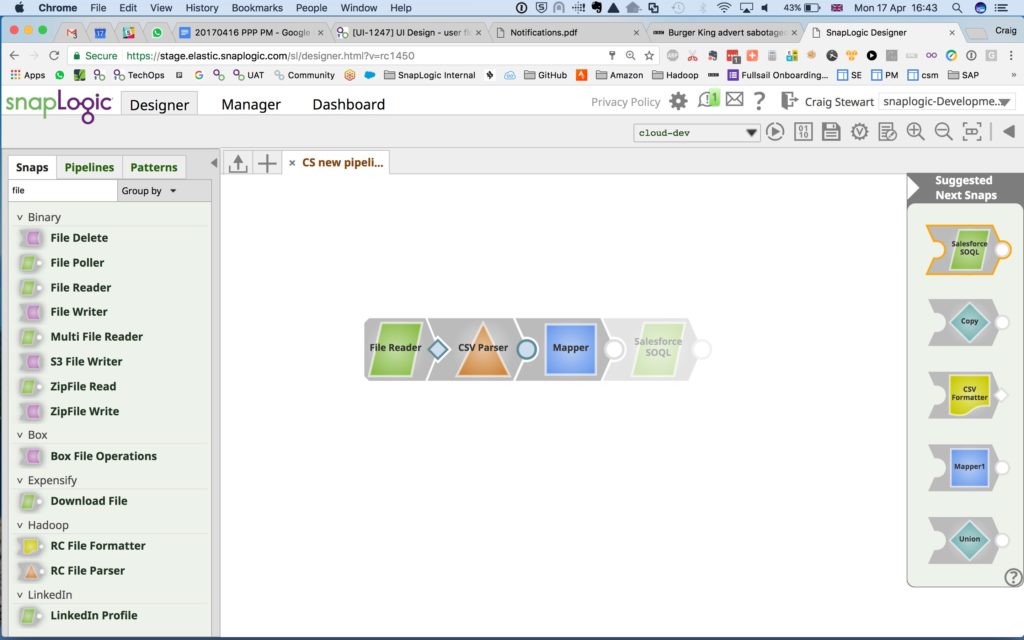Machine Learning Takes Aim at Digital Transformation Drudgery

There’s a paradox in the world of digital transformation: the goal is hyper-acceleration of applications and automation of processes across the enterprise through advanced technologies, yet creating sleek new data and process flows typically condemns the developer to a funereal procession of tasks that meanders from tedium to apathy, with an occasional side trip to monotony, mortal combat with the unseen enemy: boredom**.
SnapLogic, the maker of Integration Platform-as-a-Service (iPaaS) tools for connecting cloud data sources, this week announced what it said is the first machine learning technology to be applied to enterprise integration – “autonomous integration” is its term – to handle highly repetitive development tasks and eliminate integration backlogs that stifle digital transformation initiatives.
“Companies can’t innovate and transform their businesses if they’re bogged down in rote, repetitive tasks that don’t do much for the organization,” said Doug Henschen, vice president and principal analyst at Constellation Research. “Machine learning is emerging as the engine behind what Constellation calls human augmentation. These next-generation systems will harness the computing power and data scale of the cloud to automate routine work, so humans can concentrate on innovating and driving better business outcomes.”
SnapLogic’s vision for its implementation of machine learning technology, called Iris, is akin to that used in autonomous vehicle technology or to Alexa, Amazon’s intelligent personal assistant technology that responds to voice commands. Iris will sit in the middle of SnapLogic’s Enterprise Integration Cloud with a self-service, AI-based recommendation engine called an “Integration Assistant” that will give line of business managers, analysts and other business users “the right next steps” in connecting software and building data pipelines.
As of now, SnapLogic said, the Integration Assistant makes correct recommendations about 90 percent of the time, performance that will improve over time as Iris’s self-learning capabilities develop greater intelligence with more data and more task repetitions. Iris, available for free next month in SnapLogic’s spring release, has been in the works for about two years, said Gaurav Dhillon, SnapLogic CEO.
Iris, available for free next month in SnapLogic’s spring release, has been in the works for about two years, said Gaurav Dhillon, SnapLogic CEO.
“The more complexity you have the harder it is for a group of humans to complete the work,” Dhillon told EnterpriseTech. “The mythical man month is alive and well,” he said, and is a limiting factor that hampers many digital initiatives in the enterprise today.
Dhillon said the technology behind Iris was developed over the past two years by SnapLogic Labs and its chief scientist, Dr. Greg Benson, who also is a professor at the University of San Francisco. Iris leverages SnapLogic’s cloud-native system and metadata architecture, allowing it to do the data science involved in finding patterns and features used to train machine learning models. “Iris thus learns from data flows, integration paths, and patterns across SnapLogic’s platform, determining what’s popular, what works, and what doesn’t work,” the company said. “It then translates that learning into specific recommendations for line-of-business and IT managers, so they can save time and reduce errors while applying best practices.”
Dhillon cited human resources applications as a typical problem scenario.
“There’s a drudgery to rewiring a hire-to-retire process,” he said. “”Here’s where there’s a chance of something going wrong at every turn. You can get the fields wrong, the rules wrong, or not apply the right income taxation – so many ways the wheels can come off in that sort of process. How do you make sure the employee’s image shows up in your email directory? And so forth. That’s the kind of process that lends itself well to AI because you’re doing something that machine intelligence can recognize and get better at; the more you do it the better it gets, sort of like image recognition on your phone. Those kinds of things we excel at.”
Said Alan Leung, senior manager of data strategy and architecture at Box ,“The SnapLogic platform allows us to seamlessly transfer data between systems, without cumbersome volume limitations. We’re excited to begin leveraging the new machine learning capabilities to improve efficiencies, so we can integrate more data and automate more processes than ever before."
SnapLogic, founded in 2006, has raised $136 million in venture funding from Microsoft, Silver Lake, Ignition and Andreessen Horowitz, among other investors. Its Enterprise Integration Cloud is designed to accelerate data and process flow across cloud and on-premises applications, data warehouses, big data streams and IoT deployments. SnapLogic’s “codeless integration” eliminates what the company calls “technical debt” by enabling users to create integrations using visual drag-and-drop software. In addition, SnapLogic’s data streaming architecture delivers real-time processing for rapid data movement across the enterprise.











